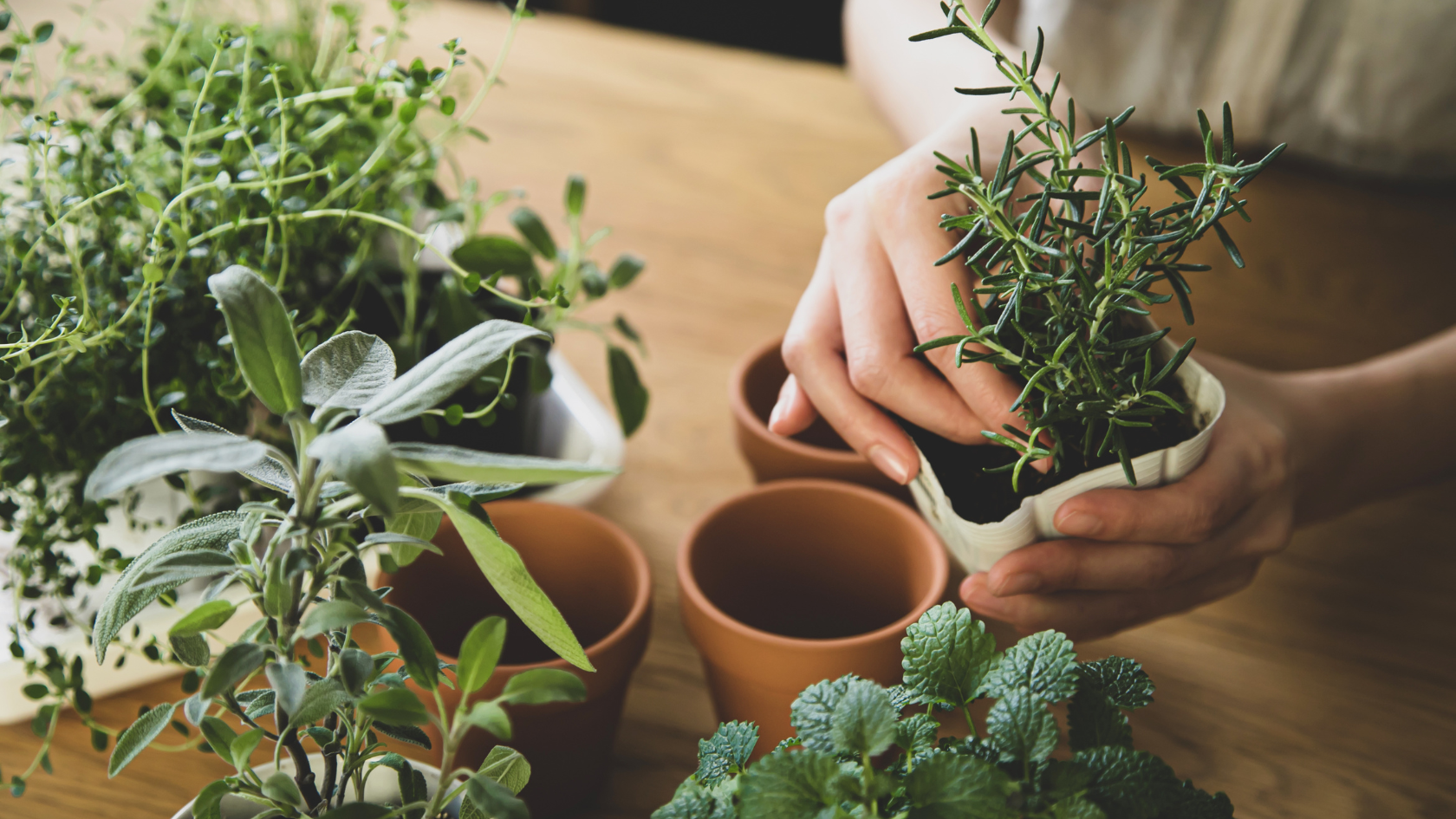
10 Best Herbs You Can Easily Grow At Home
Looking to spice up your meals and boost your health, without leaving the house? You’re in the right place.
Here are the list of 10 best herbs you can easily grow at home.
Whether you’ve got a big backyard or just a sunny windowsill, these herbs are low-maintenance, flavorful, and packed with health benefits.
10. Mint
It grows like a champ and doesn’t need much attention, which makes it perfect if you’re new to gardening.
In fact, mint is so eager to grow that it can quickly take over your garden if planted directly in the ground. That’s why most people grow it in pots to keep it contained and easy to manage.
But mint isn’t just easy to grow—it’s also incredibly useful. It contains menthol, a natural compound known for its cooling and soothing effects.
Drinking mint tea can ease indigestion, bloating, and gas, while the scent of crushed mint leaves may help relieve tension headaches and even reduce nausea.
Plus, it’s a natural breath freshener. Just chew on a few fresh leaves if you’re out of gum!
Toss it into smoothies, sprinkle it over fruit salads, or add it to cold drinks for a refreshing twist. Once you start growing mint, you’ll always find a way to use it.
9. Parsley
Parsley often gets overlooked as just a decorative garnish, but it’s actually one of the most nutrient-dense herbs you can grow at home.
It’s loaded with vitamin C to support your immune system, vitamin K for strong bones, and powerful antioxidants like flavonoids and carotenoids that help fight inflammation and cell damage.
But that’s not all—parsley is also a gentle diuretic, which means it can help reduce water retention and bloating.
Some herbalists even recommend it for supporting kidney function and flushing out excess toxins from the body. And because it’s so mild in flavor, you can sneak it into almost any meal without overpowering the dish.
It’s super easy to grow, too. Parsley does well in both containers and garden beds, and it doesn’t need much space. It prefers full sun but can tolerate a bit of shade, especially in warmer climates.
Just keep the soil moist and you’ll have a steady supply for months. Snip off the outer stems regularly to encourage new growth, and you’ll be surprised how quickly it bounces back.
8. Basil
Basil isn’t just for pesto—it’s one of the most versatile and rewarding herbs you can grow at home.
It thrives in a warm, sunny spot and grows quickly, especially during the summer months. You can grow it in a pot on your windowsill or directly in your garden, and with regular pinching of the top leaves, it just keeps producing more.
This fragrant herb is packed with antioxidants, including beta-carotene and lutein, which help protect your cells from damage.
It also has anti-inflammatory and antibacterial properties, making it more than just a flavor booster. Some studies even suggest that basil may help support heart health and balance blood sugar levels.
There are different varieties to try—like sweet basil, Thai basil, or even purple basil—each with its own unique aroma and taste. Add it fresh to pasta, sandwiches, salads, or blend it into homemade sauces for a burst of flavor and nutrition.
The best part is that the more you harvest, the more it grows!
7. Cilantro (Coriander Leaves)
Cilantro is one of those herbs people either love or hate—but if you’re a fan, you’ll be glad to know it’s incredibly easy to grow and full of benefits.
It grows quickly from seed and prefers cooler weather, making it a great herb to plant in early spring or fall. Just give it some sun and well-draining soil, and you’ll have fresh, fragrant leaves in just a few weeks.
What makes cilantro special isn’t just its zesty, citrusy flavor—it’s also packed with detoxifying properties.
Some studies suggest that cilantro may help the body eliminate heavy metals like lead and mercury, acting almost like a natural internal cleanser.
It’s also rich in antioxidants and compounds that support digestion and reduce inflammation.
One thing to note: cilantro bolts quickly in hot weather, meaning it shoots up flowers and goes to seed. Once that happens, the leaves turn bitter.
To keep a steady supply, consider sowing new seeds every couple of weeks—
what’s called “succession planting.”
That way, you’ll always have fresh leaves ready for tacos, curries, salsas, or even green smoothies.
And don’t toss those seeds—they’re coriander! Once your cilantro goes to seed, dry and save them to use as a spice or replant later.
6. Thyme
Thyme is one of the most versatile and low-maintenance herbs you can grow at home.
Whether you plant it in a garden bed or a small pot on your windowsill, this woody perennial doesn’t ask for much—just some sunlight and well-drained soil. It’s drought-tolerant, doesn’t mind poor soil, and even thrives with a little neglect, making it perfect for busy or beginner gardeners.
But thyme isn’t just tough—it’s packed with benefits.
This tiny-leaved herb has strong antibacterial and antifungal properties, thanks to compounds like thymol.
It’s often used in natural remedies for sore throats, coughs, and respiratory issues. You can steep it in hot water with lemon and honey to make a soothing herbal tea that clears up congestion and supports your immune system.
In the kitchen, thyme adds depth and earthiness to a wide range of dishes. It’s delicious in roasted vegetables, soups, stews, and even sprinkled over homemade bread or flatbreads before baking.
Plus, since it grows year-round in many climates, it’s a steady source of flavor and healing throughout the seasons.
5. Oregano
Oregano is one of those herbs that’s incredibly easy to grow—and surprisingly powerful. It’s not just something you sprinkle on pizza.
Oregano is loaded with antioxidants and compounds like carvacrol and thymol, which give it impressive antimicrobial and anti-inflammatory properties. That means it can help fight off harmful bacteria and support your immune system naturally.
Growing oregano at home is a breeze. It loves full sun and well-drained soil, and it thrives in containers just as well as in garden beds. Once it’s established, oregano doesn’t need much water or fussing over. You can snip fresh leaves to use in cooking, or dry bunches of them to store for later.
Dried oregano actually has a more concentrated flavor, so a little goes a long way.
Beyond cooking, oregano also makes a great herbal tea, especially when you’re feeling under the weather.
Oregano tea can help soothe sore throats and ease coughs during cold and flu season. Just steep a few fresh or dried leaves in hot water for 5 to 10 minutes, add a bit of honey if you like, and sip slowly.
4. Chives
Chives are one of the easiest perennial herbs you can grow—they pretty much take care of themselves once planted.
They pop back up every spring and need very little maintenance. Just give them some sunlight, a bit of water, and they’ll thrive happily in containers, window boxes, or right in your garden bed.
With their mild onion flavor, chives are a versatile addition to almost any savory dish. They’re perfect for sprinkling over scrambled eggs, roasted potatoes, soups, and creamy dips. And because they’re softer than regular onions, you don’t need to cook them—they’re best enjoyed fresh for the full flavor.
Health-wise, chives are a quiet powerhouse. They’re rich in vitamin K, which supports healthy bones and blood clotting, and they contain antioxidants like allicin that help fight inflammation and support your immune system. Plus, their mild digestive properties make them gentle on your stomach.
And let’s not forget—chives bloom with beautiful purple pom-pom flowers in the spring. These flowers are not just decorative—they’re edible and add a fun pop of color to salads or as a garnish.
3. Rosemary
Rosemary is one of those herbs that does more than just flavor your food—it lifts your mood, boosts your brain, and looks great on a sunny windowsill.
This woody Mediterranean herb is easy to grow in well-drained soil and thrives in bright sunlight. Once established, it’s quite drought-tolerant, making it perfect for forgetful waterers or warmer climates.
Its needle-like leaves pack a bold, piney flavor that goes beautifully with roasted meats, potatoes, vegetables, and homemade breads. You can even steep rosemary in olive oil or vinegar to make flavorful infusions that are great for cooking or salad dressings.
But rosemary isn’t just about taste—it’s also a traditional herbal remedy. It’s been linked to better memory and concentration, thanks to compounds like carnosic acid and rosmarinic acid, which support brain health. Just the smell of fresh rosemary is believed to improve alertness and mood.
Rosemary is also good for digestion, helping to relieve bloating and indigestion after meals. And it’s become popular in natural hair care because it may support hair growth and scalp health, especially when used as a rinse or oil infusion.
With its evergreen look and uplifting scent, rosemary is a long-lasting, multipurpose herb that’s as beautiful as it is beneficial. Just keep it in a sunny spot, trim it occasionally to encourage growth, and you’ll have a fragrant and functional plant for years.
2. Lemon Balm
Lemon balm is like nature’s chill pill in plant form. A gentle member of the mint family, it gives off a fresh, citrusy scent that instantly lifts your mood.
This calming herb has been used for centuries in traditional medicine to soothe anxiety, promote restful sleep, and support digestion, making it a must-have for anyone looking to unwind naturally.
It grows easily in pots or garden beds and does best in partial shade, although it can handle full sun in cooler climates. It spreads like mint, so keeping it in a container is often the best way to manage it. With just a little water and sunshine, it will thrive throughout the growing season.
One of the best ways to enjoy lemon balm is as a relaxing tea—just steep a few fresh leaves in hot water and add a little honey or chamomile if you like. It’s also great chopped into salads, used in fruit dishes, or even blended into herbal syrups and tinctures.
Lemon balm contains natural compounds like rosmarinic acid and citral, which are believed to help calm the nervous system, ease digestive discomfort, and even boost cognitive function in some studies.
It’s mild enough for daily use, and many people find it especially helpful during stressful times or before bed.
1. Aloe Vera
Aloe vera might not look like your typical herb, but it’s a must-have plant for any home garden, especially if you’re into natural healing.
Technically a succulent, aloe is famous for its soothing gel, which is packed with vitamins, enzymes, and anti-inflammatory compounds.
It’s a go-to remedy for burns, cuts, insect bites, and dry skin—and it works almost instantly. But aloe’s benefits go beyond the skin.
In small, food-safe amounts, the inner gel can support digestion, relieve constipation, and even help reduce inflammation in the gut. You can find aloe juice in health stores—but make sure it’s specifically labeled for internal use, as some parts of the plant (like the latex just under the skin) can be harsh if taken in large quantities.
Growing aloe vera is ridiculously easy. It thrives on neglect, making it perfect for beginners or forgetful plant parents. Just give it bright, indirect sunlight and let the soil dry out completely between waterings.
Overwatering is the most common way people kill aloe—so when in doubt, wait another day before grabbing the watering can.
Aloe vera plants also multiply by producing little baby offshoots called “pups,” which you can transplant to grow even more. Before you know it, you’ll have a whole collection of healing succulents—one for every sunny window.
For everything from skincare to gut health, aloe vera truly earns its spot at the top of the list. It’s beautiful, functional, and full of natural healing power—what more could you ask for in a houseplant?
Whether you’re after better flavor in your meals, natural health benefits, or just a fun way to connect with nature, these herbs have you covered.
Which of these are already growing in your garden—or which one are you excited to try first? Let us know in the comments!
Happy growing, stay healthy—and we’ll see you in the next one!





